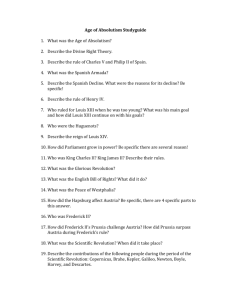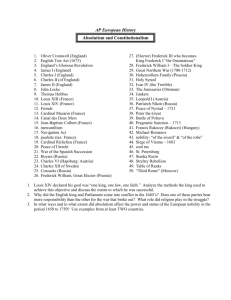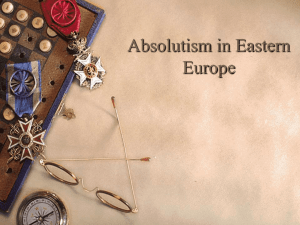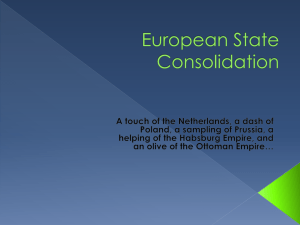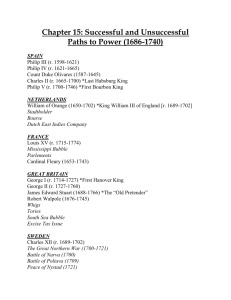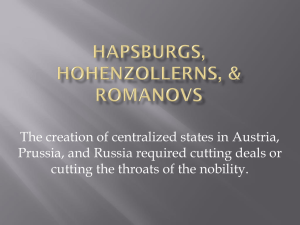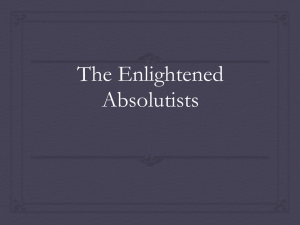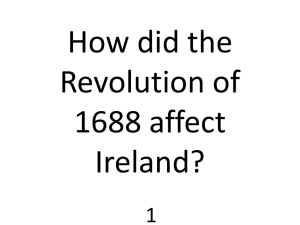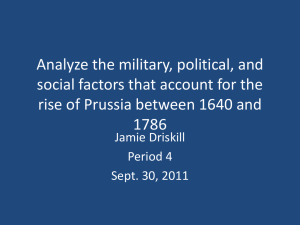Absolute Monarchs In Europe
advertisement
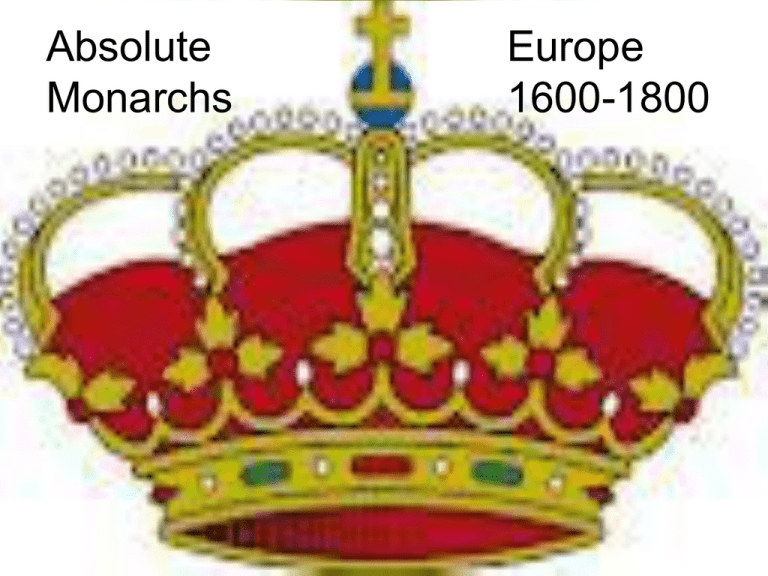
Absolute Monarchs Europe 1600-1800 Absolutism in Spain Philip II 1556-1598 Inheritance Philip II inherited the throne from his father Charles V – former Holy Roman emperor Chares V retired to a monastery in 1556 and Philip II inherited Spain, Spanish Netherlands, and American colonies. Philip II’s uncle died and then he inherited Portugal and Portuguese colonies as well Philip II’s Empire Spain Spanish Netherlands American colonies Portugal Portuguese colonies in Africa, India, and East Indies. Wealth 339,000 pounds of gold! 16,000 tons of silver 50,000 soldiers El Escorial Philip II’s Palace Fierce Defender of the Catholic Faith Defeat of the Muslim Empire 1571 250 Spanish and Venetian ships defeat a large Muslim army from the Ottoman Empire Defeat of the Spanish Armada by Queen Elizabeth in 1588 Spain and England Unite by Marriage Philip II is married to Bloody Mary I of England Mary I dies and now Philip wants Elizabeth! Elizabeth refuses to marry him Elizabeth authorizes raiding of Spanish treasure ships by English pirates Philip can’t win her love so he tries to defeat her militarily and loses! Weakening of the Spanish Empire Economic problems • Inflation caused by growing population • Increased demand for food • Merchants raise prices • Nobles don’t pay taxes • Peasants bear the tax burden • So no middle class develops Spain’s enemies get rich Jews and Moors expelled from Spain (not Catholic) Spanish merchants make things the old way Spaniards buy from England and France so money leaves Spain Spain borrows money from Germany and Italy to fight wars Dutch Revolt 1579 seven northern provinces of Protestant Netherlands declared independence from Spain William of Orange opened the dikes flooding the land and driving out Spanish ships and soldiers. Dutch became prosperous traders of TULIPS Dutch Revolt French Monarchs Henry IV of Navarre 1559-1610 • • • • • • • • Inherited throne in 1559 by marrying Catherine de Medici’s daughter after her 4 sons were ineffective First king of the Bourbon Dynasty Athletic, robust, fearless in battle and a clever politician Huguenot – French PROTESTANT 1562-1598 religious wars Passed the Edict of Nantes – declaration of religious tolerance in France Converted to Catholicism to prove his own tolerance murdered in 1610 by a religious fanatic Louis XIII 1610-1643 • Son of Henry IV – inherited after his father’s murder • Young boy • Weak ruler • so his advisor and effective ruler was Cardinal Richelieu Cardinal Richelieu advisor to Louis XIII Richelieu was known for three things: 1. Limited rights of Huguenots to build walls around cities 2. Weakened the power of the nobles 3. Made France powerful by limiting power of Hapsburgs in Austria thus involving France in the Thirty Years War over religion Louis XIV 1643 - 1715 • Nickname: Sun King • Loved ballet and to portray himself as Apollo the Sun God • Inherited the throne at age 5 when his father Louis XIII died. (unknown cause) Louis XIV’s Accomplishments 1. 2. 3. 4. 5. 6. 7. 8. Weakened power of nobles by removing them from his council Increased power of intendants to collect taxes Finance minister Jean Baptiste Colbert devoted himself to economic growth, stability and self-sufficiency, BELIEVED IN MERCANTILISM Began to manufacture everything in France Encouraged migration to Canada for fur trade Relied on colonies in New World Increased tariffs on goods from other countries Patron of the arts – art to glorify the King Louis XIV’s Mistakes/Challenges Cancelled Edict of Nantes (negative effect – many Huguenots fled) 2. Spent a fortune to surround himself in luxury 3. Self-centered expected everyone to wait on him 4. Palace at Versailles cost $2 billion dollars in 1994 money, 1400 fountains, 15,000 acres of gardens, 2,000 gardens 5. Fought disastrous wars that cost country a lot of money 6. 100,000 soldiers in peace 400,000 in wartime 7. population 20 million people 4x that of England 8. attempted to expand France’s boundaries 9. European wide alliance formed to oppose him 10. series of poor harvests 1. Louis XIV’s Legacy • • • • France became most powerful nation in Europe Left his country with staggering debt French resentment over royal abuse of power. Louis died in bed in 1715 Louis XIV’s Palace at Versailles Central European Monarchs Collapse Central European Monarchs Austria and Prussia Maria Theresa •Daughter of Charles VI Queen of Austria •1740-1780 •Last name: Hapsburg Accomplishments • Decreases the power of the nobility • Limits the forced labor of peasants • Fights Prussia – War of the Austrian Succession • Frederick II (Frederick the Great) wants Silesia- an area that produces iron ore, textiles and food products. • He doubts Maria’s power • Maria Theresa gathers an army and British support to fight Prussia and France. – Result: Maria Theresa loses Silesia in the Treaty of Aixla-Chapelle. Seven Years War • Maria Theresa makes an alliance with France • Frederick the Great signs an alliance with Great Britain • Austria, France, and Russia vs. Prussia and Great Britain. • 1756 Frederick attacks Saxony (an Austrian ally) • Seven Years war begins (1756-1763) – Territorial situation in Europe did not change. – Also known as the French and Indian War • British colonists vs. French colonists and the Native Americas – British emerge as the victors and French lost its colonies in North America. Frederick I • • • • • Country: Prussia Last name: Hohenzollerns Life span: 1657-1713 Elector of Brandenburg: 1688-1701 King of Prussia: 1701-1713 Gaining Power • Builds a strong army- best in Europe • Becomes an absolute monarch – To protect his lands • Introduced taxation • Weakened the representative assemblies of their territories Frederick William I King of Prussia 1713-1740 • Junkers- Prussia’s landowning nobility – Originally oppose Fredericks growing power – Later are given the exclusive rights to be officers in the military • Prussia becomes a strictly controlled, highly militarized society. Frederick II (Frederick the Great) • King of Prussia • Frederick the Great • 1740-1786 Frederick the Great continued • Childhood: Not military enough? – Frederick loves poetry, music, and philosophy • Runs away with a friend – Gets caught – Forced to watch his friend get beheaded • Leaves Frederick with bitter memories • Once king he follows his fathers military policies. • Softened some of his fathers laws • Encouraged religious toleration and legal reform • Believed that a ruler should be like a father to his people Wars • Won Silesia from Austria • Did not gain or loose territory during the Seven Years War • Personally lead his military forces • Considered at tactical genius in warfare – Tactics: the maneuvering of units during warfare – Strategy: the overall battle plan or means for achieving the goal The Territory of Silesia Early Prussia Expansion under Frederick the Great Russian Monarchs Ivan the Terrible • 1533-1547 Gains throne at age 3! • Struggles for power among boyars (nobles) trying to control young Ivan IV • At age 16 he seized power and crowned himself czar • Married Anastasia of the Romanov family Ivan IV – “Good Period” • • • • 1547-1560 Added lands to Russia developed a Russian code of law ruled justly. Ivan at the deathbed of his first wife, Anastasia Romanov. Ivan married 7 times, sometimes divorcing a wife a week after the marriage. Ivan’s “Bad period” • Begins in 1560 after Anastasia died. – Poisoned by the Boyars? • Ivan’s response – Secret police force – oprichnika • Hunt down and murder people who consider Ivan a traitor – He executes many Boyars, their families, and peasants who work on their land. – Takes the land and makes a new class of nobles who are loyal to him through fear. 1581 Ivan kills his oldest son during a quarrel. Ivan’s second son is mentally and physically incapable of ruling and dies a few years later with out an heir. “Time of Troubles” • • • • boyars struggled for power czars died of mysterious conditions several imposters tried to claim the throne Michael Romanov – grandnephew of Anastasia was finally chosen. • His family ruled for 300 years 1613-1917 • Family restored order to Russia over time Russia before Peter • Russia still a land of boyars and serfs – Serfs were property – Not “westernized” yet – Cut off from Renaissance & Exploration by Mongol rule – geographic barriers – ice at only seaport – Eastern orthodox branch of Christianity viewed Catholics and Protestants as heretics and avoided them Peter The Great (age 24) 1696 - 1725 • 6.5 ft tall • passion for ships and sea/fascinated by modern tools • believed Russia needed a warmer seaport • under a secret identity toured Western Europe with 55 boyars and 200 servants “Grand Embassy” • worked as an ordinary carpenter Peter’s Westernization of Russia • brought Russian orthodox church under state control and abolished head office of the patriarch – Holy Synod now runs the church under Peter’s direction Reduced power of landowners by recruiting able men from lower ranking families and giving them land grants – Now they owe their life to Peter and are loyal Modernized army (trained by European soldiers) introduced potatoes first newspaper introduced raised status of women – lets them attend social events forced nobles to wear Western clothes and shave beards built capital city of St. Petersburg on the Baltic Sea ( had to fight Sweden for it) • • • • • • • – – – swampy land 25,000 – 100,000 people died forced Russian nobles to live there and leave Moscow Catherine the Great 1762-1796 • seized the throne of her weak husband Peter III (Peter was mentally unstable, played with toy soldiers and tortured his dogs – marriage was a disaster) • she had him arrested and confined and then died mysteriously! • German princess • Easily adopted Russian ways and the respect of her people • Believed it went against Christian values to enslave people Catherine Rules Absolutely • A peasant rebellion persuaded her not to free them right away…She crushed them! • Successful foreign policy • Expanded boundaries even further • Gained warm water port on Black sea now too by defeating the Ottoman Turks • Acquired territory from Poland (Prussia and Austria took the rest and Poland did not exist again until 1919) BUT ALSO: • reorganized the provincial government, codified laws, and began state-sponsored education for boys and girls The English Monarchy 1509-1820 Henry VIII 1509-1547 Act of Supremacy 6 Wives “Divorced, beheaded, died, divorced, beheaded, survived” 1. Catherine of Aragon 2. Anne Boelyn 3. Jane Seymour 4. Anne of Cleves 5. Catherine Howard 6. Catherine Parr Henry VIII Broke economic, spiritual and political ties with the Catholic Church Built Royal Navy Consulted with Parliament often when in need of &, Parliament passed new taxes Avid gambler, dice player, and athlete (tennis, jousting, hunting)musician, author and poet Died of obesity, ulcerations, possibly Type II diabetes Edward VI 1547-1553 Regency Council Young and weak Abolished clerical celibacy and mass to firmly establish Protestantism Economic and social unrest Died at age 15 Mary I (Bloody Mary) 1553-1558 Catholic Married to Philip II Burned Protestants Mother is Catherine of Aragon Trade suffered Drawn in to many Spanish wars Lost Calais to French Elizabeth 1558-1603 Virgin Queen Established Anglican Church Refused Philip II Did not outlaw piracy of Spanish ships Defeated Spanish Armada Executed Mary Queen of Scots (cousin) Controlled but consulted with Parliament No Heir James I (James VI of Scotland) 1603-1625 Son of Mary Queen of Scots – unites Scotland & England under one crown Believed in Divine right/would not share power with Parliament Conflict between King and Parliament tears country apart Low taxes, peace Gunpowder plot Charles I 1625 - 1649 Son of James I Petition of Right – limited King’s power to tax, martial law, and ¼ing of troops Wants to unify religion in Scot and Eng Scots invade England, Irish rebel Keeps dissolving Parliament but calls it back for more $ English Civil War Charles I vs. Oliver Cromwell Cavaliers vs. Roundheads Charles I is executed "he, the said Charles Stuart, as a tyrant, traitor, murderer and public enemy to the good of this nation, shall be put to death by severing of his head from his body." Oliver Cromwell 1649-1661 Crushed revolts in Scotland and Ireland Puritan laws Ended up under military rule to enforce these laws Contradicted everything fought for in the Civil War Charles II 1661-1685 12 Children from 7 mistresses Restoration of the Crown Merry Monarch Constitutional Monarchy Next in line=brother James II 1st political parties – Whigs (don’t want Catholic King) Tories (defended hereditary monarchy) Tories win but Whigs get Habeas corpus – can’t be held in prison without trial or just cause Married queen of Portugal Sold Carolinas to nobles Sold Dunkirk to his cousin Louis XIV of France. Great fire of London Great Plague of London James II 1685-1689 Ignores Parliament and appoints Catholics to high positions Abdicates Throne William and Mary 1689-1702 James II 2nd wife has a son- Mary is his Prot daughter Glorious Revolution English Bill of Rights Act of Settlement – excludes any Catholic from inheriting the throne Anne 1702-1714 Act of Union – Scotland & England united as Great Britain Cabinet formed George I 1714-1727 Position of Prime Minister founded George II 1727-1760 Establishment of Constitutional Monarchy officially George III 1760-1820 Gained land in North America after French and Indian War against France War debt = taxes = rebellion of colonies = American Revolution
